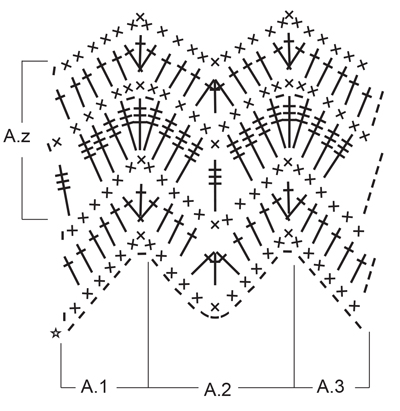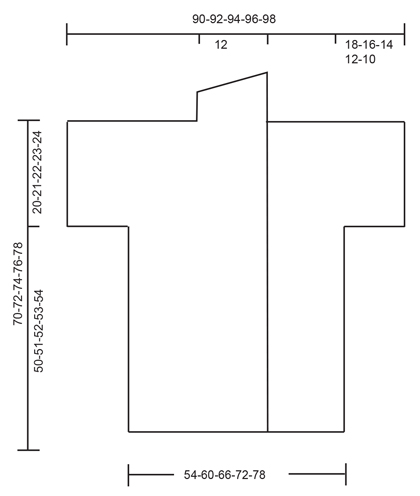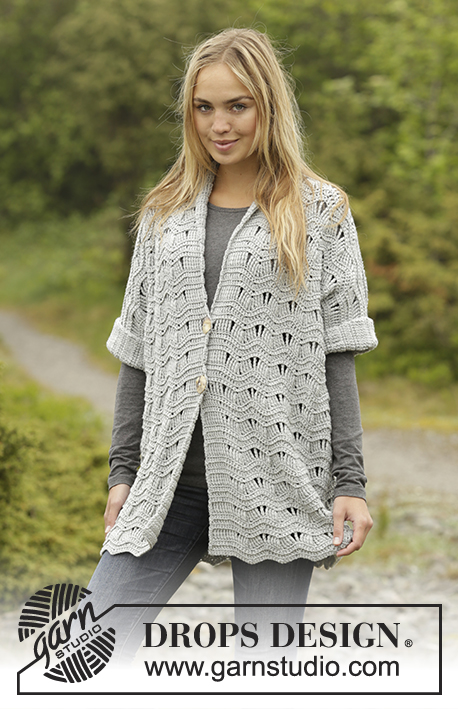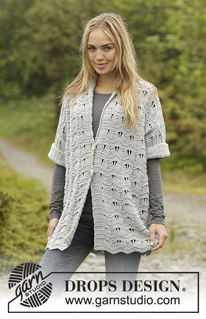Silver Rain |
||||||||||||||||
|
|
||||||||||||||||
Crochet DROPS jacket with seamless sleeves and wave pattern in ”Merino Extra Fine”. Sizes S/M - XXXL.
DROPS Extra 0-1310 |
||||||||||||||||
|
PATTERN: See diagrams A.1 to A.6. CROCHET TIP: Work every row from RS in the back loop of st on previous row and work every row from WS in the front loop of st on previous row. Work every row with sc from WS. Sts that are not worked in diag are worked like the first st in the pattern, i.e. Work the sts in sc on rows with sc in it. NOTE: These sts are also worked in the back and front loop in relation to RS and WS. CROCHET INFO: Beg every row with dc with 3 ch (replaces first dc) Beg every row with sc with 1 ch (replaces first sc) Beg every row with dtr with 5 ch (replaces first dtr) ---------------------------------------------------------- JACKET: Work from back piece and up towards the neck, then divide the piece and work down each front piece. BACK PIECE: Work 110-122-134-146-158 ch (includes 1 ch for turning) with hook size 5 mm and Merino Extra Fine. Work 1st row of A.1 to A.3 (with sc) from WS as follows: Work A.1 over the 1st 8 ch (includes the ch for turning), then A.2 over the next 96-108-120-132-144 ch (= in total 8-9-10-11-12 times in width), and finish with A.3 over the last 6 ch – READ CROCHET TIP! Continue in pattern like this. Repeat A.z in height. REMEMBER THE CROCHET GAUGE! When piece measures approx. 50-51-52-53-54 cm / 19 3/4"-20"-20½"-21"-21 1/4" – make sure that next row is a row with dc (= from RS) – cut the thread. Then work the sleeves as follows: Work 25-22-20-17-14 LOOSE ch, continue working over the back piece from RS like this: Work A.6 over A.3, A.5 over A.2 and A.4 over A.1 - NOTE: Adjust which row in pattern A.6, A.5 and A.4 to start with so that the pattern continues with the similar row as before,and finish with 25-22-20-17-14 LOOSE ch (includes 1 ch for turning) – READ CROCHET INFO, turn the piece. Work from RS like this: Work 1 sc in the 2nd ch from hook (= 2 sc), 1 sc in each of the next 23-20-18-15-12 ch, work A.4, A.5 and A.6 as before, work 1 sc in each of the last 25-22-20-17-14 ch = 25-22-20-17-14 sc in each side of the piece and A.4 to A.6 (= in total 159-165-173-179-185 sts). The first and last 25-22-20-17-14 sts are not worked in diag, but like the first st in diag, i.e. Work dtr in i diag work sleeve sts like dtr – REMEMBER THE CROCHET TIP! Continue like this until work measures in total 70-72-74-76-78 cm / 27½"-28½"-29"-30"-30 3/4", make sure that next row is a row from RS, put piece aside and work the shawl collar. RIGHT SHAWL COLLAR: Work 34-39-34-39-34 ch (inkl 3 ch for turning) with hook 5 and Merino Extra Fine. Work 1 dc in the 4th ch from hook (= 2 dc), 1 dc in each of the next 2-0-2-0-2 ch, * skip1 ch, 1 dc in each of the next 6 ch *, repeat from *-* = 28-32-28-32-28 dc. Then work as follows: 1st ROW (= RS: 5 sc, 5 hdc, 18-22-18-22-18 dc. 2nd ROW (= WS): Work 1 dc in each of the 28-32-28-32-28 sts. Repeat 1st and 2nd row until piece measures approx. 6-6-7-7-8 cm / 2½"-2½"-2 3/4"-2 3/4"-3" in the most narrow part – make sure to finish with the 2nd row (= WS). Cut and fasten the thread. RIGHT FRONT PIECE Then work right front piece tog with the right shawl collar from RS as follows: Beg on the outermost part of sleeve: Work the first 25-22-20-17-14 sts like the first st in the pattern as before, A.6 as before (= 6 sts), repeat A.5 over the next 36-36-48-48-60 sts (= in total 3-3-4-4-5 times in width), work next A.5 over the next 0-6-0-6-0 sts on the back piece and the first 12-6-12-6-12 dc from the shawl collar, repeat A.5 in total 0-1-0-1-0 more time, A.4 over the next 7 dc, and finish with 9-7-9-7-9 sts like the first st in the pattern (= front band) = repeat A.5 in total 4-5-5-6-6 times in width (= 95-102-102-109-108 sts). Continue in pattern like this. When piece measures 40-42-44-46-48 cm / 15 3/4"-16½"-17 1/4"-18"-19" from where ch for sleeve were worked (Piece measures in total 90-93-96-99-102 cm / 35½"-36½"-37 3/4"-39"-40"), make sure to work the next row from RS. Cut the thread. Skip the first 25-22-20-17-14 sts (= for sleeve), work A.3 over A.6 (adjust to the row in pattern) and A.5 and A.4 as before, and 9-7-9-7-9 sts like the first st in the pattern (= 70-80-82-92-94 sts). When piece measures 50-51-52-53-54 cm / 19 3/4"-20"-20½"-21"-21 1/4" from where sts for sleeve were skipped (work measures in total 140-144-148-152-156 cm / 55"-56½"-58"-59 3/4"-61 1/4"), make sure to finish with 1 whole repeat of A.z (make sure the number of repeats in height matches the number of repeats in back piece). Cut and fasten the thread. LEFT SHAWL COLLAR: Work 33-37-33-37-33 ch (includes 3 ch for turning) with hook 5 mm and Merino Extra Fine. Work 1 st in the 4th ch from hook (= 2 dc), 1 st in each of the next 1-5-1-5-1 ch, * skip ch 1, 1 dc in each of the next 6 ch *, repeat from *-* = 27-31-27-31-27 dc. Then work as follows: 1st row (= RS): Work 17-21-17-21-17 dc, 5 hdc and 5 sc. 2nd row (= WS): Work 1 dc in each of the 27-31-27-31-27 sts. Repeat 1st and 2nd row until work measures approx. 6-6-7-7-8 cm / 2½"-2½"-2 3/4"-2 3/4"-3" in the most narrow part – make sure to finish with 2nd row (= WS). LEFT FRONT PIECE: Do not work any longer over the mid 24 sts (= 2 repeats of A.5) = neck. Work left front piece tog with left shawl collar from RS like this: work the first 9-7-9-7-9 sts from shawl collar like the first st in the pattern, A.6 over the next 6 dc from shawl collar, A.5 in total 0-1-0-1-0 time over shawl collar, repeat A.5 over the next 12-6-12-6-12 dc from shawl collar, skip 24 sts for neck between the right and left front piece (= 2 repeats of A.5), work the remaining 0-6-0-6-0 sts of A.5 over de first 0-6-0-6-0 dc from front piece, repeat A.5 over de next 36-36-48-48-60 sts, A.4 over the next 7 sts, work the next 25-22-20-17-14 sts like the first st in the pattern as before= repeat A.5 in total 4-5-5-6-6 times in width (= 95-102-102-109-108 sts). Continue in pattern like this. When piece measures 40-42-44-46-48 cm / 15 3/4"-16½"-17 1/4"-18"-19" from where ch for sleeve were worked (work measures in total 90-93-96-99-102 cm / 35½"-36½"-37 3/4"-39"-40"), make sure that next row is a row from RS. Work like this from RS: Work 9-7-9-7-9 sts like the first st in diag as before, A.6 as before, repeat A.5 as before, Work A.1 over A.4, turn and work back again (= 70-80-82-92-94 sts). I.e. do not work any longer over the last 25-22-20-17-14 sts (= sleeve). When piece measures 50-51-52-53-54 cm / 19 3/4"-20"-20½"-21"-21 1/4" from where sts for sleeve were skipped (Work measures in total 140-144-148-152-156 cm / 55"-56½"-58"-59 3/4"-61 1/4"), make sure to finish with 1 whole repeat of A.z (adjust the pattern after right front piece). Cut and fasten the thread. ASSEMBLY: Start at the bottom and work the sides together through both layers from WS as follows: 1 sc, * ch 3, skip 1 cm / 3/8'', 1 sc around next row *, repeat from *-* along the whole side and finish with 1 sc. Continue working under sleeve through both layers as follows: * ch 1, 1 sc in the next st *, repeat from *-* and make sure to finish with 1 sc. Work the collar together mid back like this: 1 sc, * ch 1, 1 sc in the next dc *, repeat from *-*. Sew the collar to the neck. Fold an edge on the sleeves and fasten with a stitch to keep the edge up. Sew on buttons. The buttons are buttoned through the row of dtr on the front band. |
||||||||||||||||
Diagram explanations |
||||||||||||||||
|
||||||||||||||||

|
||||||||||||||||

|
||||||||||||||||

|
||||||||||||||||
|
Have you made this or any other of our designs? Tag your pictures in social media with #dropsdesign so we can see them! Do you need help with this pattern?You'll find tutorial videos, a Comments/Questions area and more by visiting the pattern on garnstudio.com. © 1982-2024 DROPS Design A/S. We reserve all rights. This document, including all its sub-sections, has copyrights. Read more about what you can do with our patterns at the bottom of each pattern on our site. |
||||||||||||||||










































Comments / Questions (13)
I tried to comment but each time it was too long and then it said I was a spammer so now I dont care about drawing the mistake to your attention.
20.02.2017 - 08:41DROPS Design answered:
Dear Mrs Morandin, you can try again to shorten your comment or then send your feedback to your Drops store, who will forward us. Thank you. Happy crocheting!
20.02.2017 - 11:01Im having trouble doing the back of this pattern. The crochet tips say to crochet stitches not shown in pattern as is the first stitch in pattern, however the sides of the back keep growing on the diagonal. I've gone from 6 stitches to over 10 in less than 6 rows. If I do as the pattern shows I would then have hanging left over stitches on each side. How is the correct way to work the beginning and ending 6 stitches?
12.02.2017 - 17:56DROPS Design answered:
Dear Mrs Yearick, you should always have the same number of sts and repeat in width, and it should be "straight". Sarting from WS work: A.1 (= over the first 8 chains/sts), repeat A.2 a total of 8-12 times (see size), and finish with A.3 (= over the last 6 chains/sts). From RS work: A.3, repeat A.2 and finish with A.1. Then repeat the last 4 rows in diagram (= A.z). Happy crocheting!
13.02.2017 - 11:32Hallo, ich habe Probleme, den Kragen und das Vorderteil zusammen zu bekommen. Ist es richtig, dass die Blende nur über den Kragen gehäkelt wird und nicht über das Rückenteil? Und wie wird dann zu Schluss der Kragen an den Halsausschnitt genäht? Da sind doch nur 24 Maschen "frei". Bis hierhin bin ich super klargekommen, aber dieser Schritt will mir nicht gelingen. Vielen Dank für die Hilfe!
23.01.2017 - 07:24DROPS Design answered:
Liebe Frau Schünemann, wenn Sie das rechte Vorderteil häkeln, wird der 1. Reihe von dem Ärmel anfangen, dann mit A.5 über die ersten Stb des Schalkragens, A.4 häkeln, und mit den Blendemasschen enden, so werden alle M von dem Kragen gehäkelt. Viel Spaß beim häkeln!
23.01.2017 - 11:08